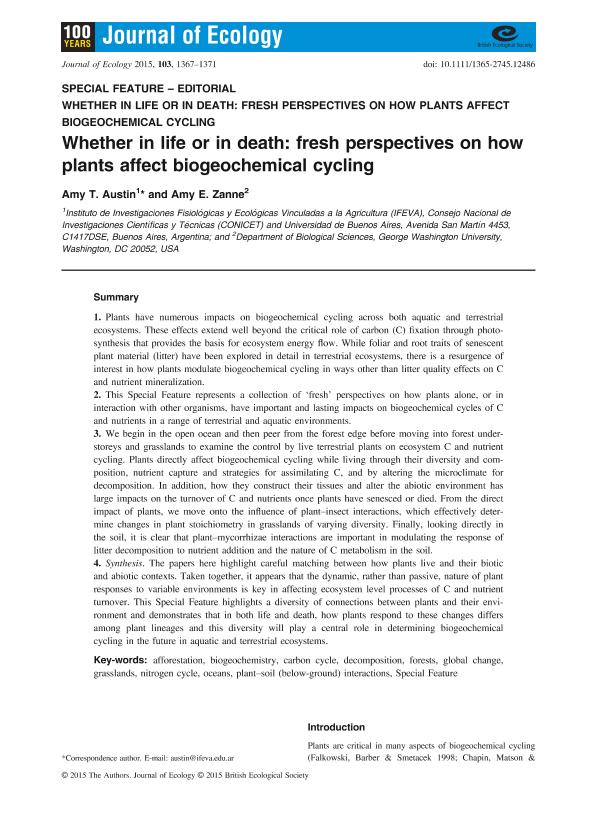Artículo
Whether in life or in death: fresh perspectives on how plants affect biogeochemical cycling
Fecha de publicación:
11/2015
Editorial:
Wiley
Revista:
Journal Of Ecology
ISSN:
0022-0477
Idioma:
Inglés
Tipo de recurso:
Artículo publicado
Clasificación temática:
Resumen
1. Plants have numerous impacts on biogeochemical cycling across both aquatic and terrestrial ecosystems. These effects extend well beyond the critical role of carbon (C) fixation through photosynthesis that provides the basis for ecosystem energy flow. While foliar and root traits of senescent plant material (litter) have been explored in detail in terrestrial ecosystems, there is a resurgence of interest in how plants modulate biogeochemical cycling in ways other than litter quality effects on C and nutrient mineralization. 2. This Special Feature represents a collection of ‘fresh’ perspectives on how plants alone, or in interaction with other organisms, have important and lasting impacts on biogeochemical cycles of C and nutrients in a range of terrestrial and aquatic environments. 3. We begin in the open ocean and then peer from the forest edge before moving into forest understoreys and grasslands to examine the control by live terrestrial plants on ecosystem C and nutrient cycling. Plants directly affect biogeochemical cycling while living through their diversity and composition, nutrient capture and strategies for assimilating C, and by altering the microclimate for decomposition. In addition, how they construct their tissues and alter the abiotic environment has large impacts on the turnover of C and nutrients once plants have senesced or died. From the direct impact of plants, we move onto the influence of plant–insect interactions, which effectively determine changes in plant stoichiometry in grasslands of varying diversity. Finally, looking directly in the soil, it is clear that plant–mycorrhizae interactions are important in modulating the response of litter decomposition to nutrient addition and the nature of C metabolism in the soil. 4. Synthesis. The papers here highlight careful matching between how plants live and their biotic and abiotic contexts. Taken together, it appears that the dynamic, rather than passive, nature of plant responses to variable environments is key in affecting ecosystem level processes of C and nutrient turnover. This Special Feature highlights a diversity of connections between plants and their environment and demonstrates that in both life and death, how plants respond to these changes differs among plant lineages and this diversity will play a central role in determining biogeochemical cycling in the future in aquatic and terrestrial ecosystems.
Archivos asociados
Licencia
Identificadores
Colecciones
Articulos(IFEVA)
Articulos de INST.D/INV.FISIOLOGICAS Y ECO.VINCULADAS A L/AGRIC
Articulos de INST.D/INV.FISIOLOGICAS Y ECO.VINCULADAS A L/AGRIC
Citación
Austin, Amy Theresa; Zanne, Amy E.; Whether in life or in death: fresh perspectives on how plants affect biogeochemical cycling; Wiley; Journal Of Ecology; 103; 6; 11-2015; 1367-1371
Compartir
Altmétricas




